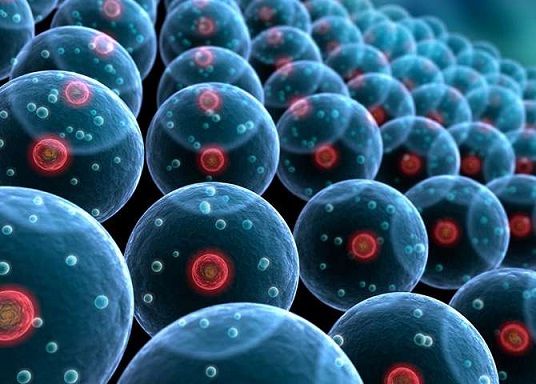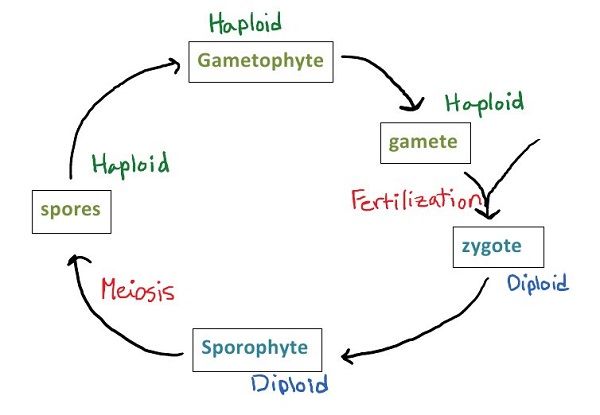Science Trilogy: Variation based classification, nucleus dependent heritable attributes and alternation of generations

Variation and classification
In my last post, I discussed how Man has always endeavoured to simplify the world around him. The tremendous number of the different forms will be impossible to analyse if it coild not be reduced to groups that can be comprehended. For example, man first separates living things from non-living things using some basic characteristics like MR NIGER D (movement, respiration, nutrition, irritability, growth, excetion, reproduction and death), and as his understanding increases, he shifted his ground of what separates a living from non-living. Virus is a case of reference. LIfe is again sub-divided into plant and animals; although some lower living forms such as Euglena present some problems in that they exhibit both plant and animal characteristics.
The plant and animal kingdoms are therefore ordered in classificatory units based on similarities. The adopted hierarchical system today was first published by Linnaeus in 1735 as follows:
- Kingdom
- Phylum
- Class
- Order
- Family
- Genus
- Species
For example, the edible cowpea belongs to the phylum Tracheophyta, class Angiospermae, order Rasales, family Leguminosae, genus Vigna and species unguiculata. This classificatory system facilitates the study of either a known or new organism. While Linnaeus did not systematise is as such at the time, his clssificatory system reflects on the evolutionary history of organisms and sets reproductive limits. It represents an effort to organize the large amount of variation among different organisms.
The variation between major classificatory units are all heritable and are transmitted from one generation to the next, and it is for this reason that each group maintains its identity. The science of genetics has been built largely on variation that exists at the sub-species level. In fact, the bulk of our knowledge in genetics comes from differences that exist between individuals as species. This has been so for some reasons. Genetic study is based largely on our ability to cross two individuals followed by an analysis of the offspring. It is usually easier to cross within a species than between species. Intergenetic crosses usually prsent problems. For easier interpretation of progenies of a cross within a species, the fewer the differences between the parental lines that are under study, the clearer the interpretation one can make from such a cross. For this reason, it is common to maintain lines with known history in genetic laboratories.
Nucleus and heritable attributes
Human's interest in heredity is as old as the ability to notice differences between organisms and awareness that some differences represent reproductive limits. The primitive man aided the evolution of the domestic animals and major crops. The degree of his success can be measured by the tremendous range of crops and animals on which human beings depend for their foods. Modern man has we have it presently, has not added a single new species to domesticated animals or food crops. Readers can argue that in the comment section of this post.
Even before Mendel, man in all cultures has speculated on how variation is transmitted from parents to offspring. Since in higher animals, conception is always preceded by mating, man has naturally construed semen as a vehicle of inheritance. Hertwig in 1876 observed and described the union of the male sprm and female ovum in the sea urchin. It thus seems that hereditary factors are transmitte through single cells, and development of an egg starts only after fertilization by a sperm.
The single cells in form of sperm and egg are composed of two, more or less distinct regions; a dense reigon called nucleus and a less dense surrounding medium, the cytoplasm. If one compares the egg and the sperm of a mammal, the nucleus of both are about equal in size whereas, the cytoplasm of the egg is much larger than that of the sperm. In fertilization, it is mainly the nucleus of the sperm that fuses with the nucleus of the egg while the tail is shed off. Thus, the contribution of the male to the offspring is through the nucleus of the sperm.
It has also been observed that in a dividing cell, the nucleus goes through marked changes whereas the cytoplasm is remarkably inactive. In addition, cytoplasmic contents of the different cells of the same organism exhibit large differences and some of these differences can be associated with the location of the cells. Thus, chloroplasts are very abundant in leaf cells. All these suggest that the nucleus play a vital role in heredity.
In order to further elucidate the importance of nucleus in heredity, an experiment using a single-celled alga Acetabularia offer excellent proof. Acetabularia wettsteinii and Acetabularia mediterranea differ in their fruiting bodies, that is the cap. By interchange of their nuclei through microsurgery or by grafting a decapped stem of one species to the nucleate base of another species. It was demonstrated that the nucleus determines the type of fruiting body produced. This experiment effectively concluded that hereditary factors reside in the nucleus of the cell and not in the cytoplasm.
Life cycles and alternation of generations
In sexually reproducing organisms, the male and females sex cells or gametes fuse to form a zygote which then divides mitotically and differentiates to form various tissues of the adult organism. Processes ensure that the chromosome number of organism is kept constant in succesive generations. The mechanism that accomplish this process is known as meiosis and it involves halving of the chromosome complement during the production of gametes, a process referred to as gametogenesis. The 2n sporophyte is said to be diploid while the gametophyte and the gametes are saide to be haploid (n).

The alternation of life cycle of organisms between these two stages, that is sporophyte and gametophyte or diploid/haploid is what is generally referred to as alternation of generation. In many fungi, the haploid stage is the conspicous stage. In the mosses, both states appear equally prominent and physiologically interdependent. From the ferns to the angiosperms, the diploid generation becomes more prominent and the two generations are independent.. In the higher plants, the haploid generation is reduced to a few cells while in many higher animals such as man, the haploid stage is just one cell, that is egg or sperm.
Thank you for reading.
References
[access excellence](http://www.accessexcellence.org/RC/VL/GG/hammerling_s.html}




This is a test comment, notify @kryzsec on discord if there are any errors please.
Being A SteemStem Member
Let me say this topic is pure science. I had to read it over again to be be able to understand it properly. Hence I agree with you on this;
SIncere apologies for I could not find simpler words to use for non-science folks to be able to understand. Thanks for reading through all the same :)
Great read. In the interest of opening the debate on lack of novel modern domestic animals, the best example I can think of would be the Russian domestic fox experiment, conducted by zoologist Dmitry Belyayev beginning in 1959. The domestic variety was created for the purposes of understanding the domestication process. By the 4th generation, pups had begun to exhibit dog like responses to handlers. Subsequent generations exhibited more and more domesticated traits. Eventually, the foxes were expressing most of the domesticated traits. The adult foxes began to exhibit widened skulls, shortened snouts, floppy ears, curly tails, which are all juvenile traits certain domesticated species retain in adulthood. Many other behavioral changes occurred, that are hallmarks of domestication.
There are many other species that have been "domesticated" in the last 150 years or so, particularly the model organisms that are bred on a large scale for scientific studies.
Eukaryotes aside, many other organisms that have far shorter generation times have been "domesticated" in systems such as fermented foods.
I put quotation marks around domestication in two cases as domestication may be interpreted differently.